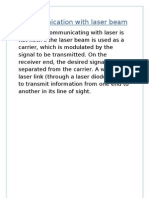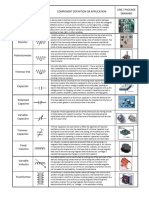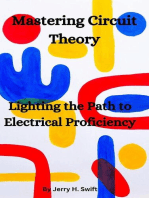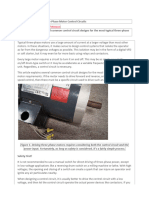Basic Electrical Components
Basic Electrical Components
Uploaded by
Er Paramjit SinghCopyright:
Available Formats
Basic Electrical Components
Basic Electrical Components
Uploaded by
Er Paramjit SinghOriginal Description:
Copyright
Available Formats
Share this document
Did you find this document useful?
Is this content inappropriate?
Copyright:
Available Formats
Basic Electrical Components
Basic Electrical Components
Uploaded by
Er Paramjit SinghCopyright:
Available Formats
Basic Electrical Components
There are several important basic electrical components that are commonly found in the circuits of virtually all PC parts and peripherals. These devices are the fundamental building blocks of electrical and electronic circuits, and can be found in great numbers on motherboards, hard disk logic boards, video cards and just about everywhere else in the PC, including places that might surprise you. They can be used and combined with each other and dozens of other devices, in so many different ways that I could not even begin to describe them all. Still, it is useful to know a bit about how they work, and this page will at least provide you with a basis for recognizing some of what you see on those boards, and perhaps understanding the fundamentals of circuit schematics. Bear in mind when reading the descriptions below that it would really take several full pages to fully describe the workings of most of these components! Fortunately, this level of detail isn't really necessary to provide the background necessary when working with PCs.
Battery: A direct current electricity source of a specific voltage, used primarily in small circuits. Resistor: As you could probably guess from the name, a resistor increases the resistance of a circuit. The main purpose of this is to reduce the flow of electricity in a circuit. Resistors come in all different shapes and sizes. They dissipate heat as a result of their opposing electricity, and are therefore rated both in terms of their resistance (how much they oppose the flow of electrons) and their power capacity (how much power they can dissipate before becoming damaged.) Generally, bigger resistors can handle more power. There are also variable resistors, which can have their resistance adjusted by turning a knob or other device. These are sometimes called potentiometers. Capacitor: A capacitor is a component made from two (or two sets of) conductive plates with an insulator between them. The insulator prevents the plates from touching. When a DC current is applied across a capacitor, positive charge builds on one plate (or set of plates) and negative charge builds on the other. The charge will remain until the capacitor is discharged. When an AC current is applied across the capacitor, it will charge one set of plates positive and the other negative during the part of the cycle when the voltage is positive; when the voltage goes negative in the second half of the cycle, the capacitor will release what it previously charged, and then charge the opposite way. This then repeats for each cycle. Since it has the opposite charge stored in it each time the voltage changes, it tends to oppose the change in voltage. As you can tell then, if you apply a mixed DC and AC signal across a capacitor, the capacitor will tend to block the DC and let the AC flow through. The strength of a capacitor is called capacitance and is measured in farads (F). (In practical terms, usually microfarads and the like, since one farad would be a very large capacitor!) They are used in all sorts of electronic circuits, especially combined with resistors and inductors, and are commonly found in PCs. Inductor: An inductor is essentially a coil of wire. When current flows through an inductor, a magnetic field is created, and the inductor will store this magnetic energy until it is released. In some ways, an inductor is the opposite of a capacitor. While a capacitor stores voltage as electrical energy, an inductor stores current as magnetic energy. Thus, a capacitor opposes a change in the voltage of a circuit, while an inductor opposes a change in its current. Therefore, capacitors block DC current and let AC current pass, while inductors do the opposite. The strength of an inductor is called--take a wild guess--its inductance, and is measured in henrys (H). Inductors can have a core of air in the middle of their coils, or a ferrous (iron) core. Being a magnetic material, the iron core increases
the inductance value, which is also affected by the material used in the wire, and the number of turns in the coil. Some inductor cores are straight in shape, and others are closed circles called toroids. The latter type of inductor is highly efficient because the closed shape is conducive to creating a stronger magnetic field. Inductors are used in all sorts of electronic circuits, particularly in combination with resistors and capacitors, and are commonly found in PCs. Transformer: A transformer is an inductor, usually with an iron core, that has two lengths of wire wrapped around it instead of one. The two coils of wire do not electrically connect, and are normally attached to different circuits. One of the most important components in the world of power, it is used to change one AC voltage into another. As described above, when a coil has a current passed through it, a magnetic field is set up proportional to the number of turns in the coil. This principle also works in reverse: if you create a magnetic field in a coil, a current will be induced in it, proportional to the number of turns of the coil. Thus, if you create a transformer with say, 100 turns in the first or primary coil, and 50 turns in the second or secondary coil, and you apply 240 VAC to the first coil, a current of 120 VAC will be induced in the second coil (approximately; some energy is always lost during the transformation). A transformer with more turns in its primary than its secondary coil will reduce voltage and is called a step-down transformer. One with more turns in the secondary than the primary is called a step-up transformer. Transformers are one of the main reasons we use AC electricity in our homes and not DC: DC voltages cannot be changed using transformers. They come in sizes ranging from small ones an inch across, to large ones that weigh hundreds of pounds or more, depending on the voltage and current they must handle. Diode / LED: A diode is a device, typically made from semiconductor material, that restricts the flow of current in a circuit to only one direction; it will block the bulk of any current that tries to go "against the flow" in a wire. Diodes have a multitude of uses. For example, they are often used in circuits that convert alternating current to direct current, since they can block half the alternating current from passing through. A variant of the common diode is the light-emitting diode or LED; these are the most well-known and commonly-encountered kind of diode, since they are used on everything from keyboards to hard disks to television remote controls. An LED is a diode that is designed to emit light of a particular frequency when current is applied to it. They are very useful as status indicators in computers and battery-operated electronics; they can be left on for hours or days at a time because they run on DC, require little power to operate, generate very little heat and last for many years even if run continuously. They are now even being made into low-powered, long-operating flashlights. Fuse: A fuse is a device designed to protect other components from accidental damage due to excessive current flowing through them. Each type of fuse is designed for a specific amount of current. As long as the current in the circuit is kept below this value, the fuse passes the current with little opposition. If the current rises above the rating of the fuse-due to a malfunction of some sort or an accidental short-circuit--the fuse will "blow" and disconnect the circuit. Fuses are the "heroes" of the electronics world, literally burning up or melting from the high current, causing a physical gap in the circuit and saving other devices from the high current. They can then be replaced when the problem condition has been corrected. All fuses are rated in amps for the amount of current they can tolerate before blowing; they are also rated for the maximum voltage they can tolerate. Always
replace a blown fuse only with another of the same current and voltage rating.
You might also like
- Half Wave Rectifier PDFDocument23 pagesHalf Wave Rectifier PDFArjun SinghNo ratings yet
- Wind Power Plant Testing and CommissioningDocument4 pagesWind Power Plant Testing and CommissioningaNo ratings yet
- Condenser.: Capacitor - in A Way, A Capacitor Is A Little Like A Battery. Although They Work in Completely Different WaysDocument8 pagesCondenser.: Capacitor - in A Way, A Capacitor Is A Little Like A Battery. Although They Work in Completely Different WaysJuan DelacruzNo ratings yet
- The TCP/IP Guide See Here For More The PC Guide Tip Jar: Custom SearchDocument6 pagesThe TCP/IP Guide See Here For More The PC Guide Tip Jar: Custom SearchSeverino CantubaNo ratings yet
- A Printed Circuit BoardDocument7 pagesA Printed Circuit BoardmrhailgvnNo ratings yet
- Noor Al-Salehi - Basic Electronics Components and CircuitsDocument22 pagesNoor Al-Salehi - Basic Electronics Components and Circuitsapi-525647046No ratings yet
- Assignment 1: Domestic Electrical Equipment Maintenance Section 2Document11 pagesAssignment 1: Domestic Electrical Equipment Maintenance Section 2Ganabpaty ThiagarajanNo ratings yet
- Electronic Part ADocument25 pagesElectronic Part AMahmoud Nagy ZedanNo ratings yet
- IdentificationDocument2 pagesIdentificationarvind_rj31No ratings yet
- Basic Circuit ComponentsDocument3 pagesBasic Circuit ComponentsJhoker SudzNo ratings yet
- Clap SwitchDocument19 pagesClap SwitchNithin Peter80% (5)
- Active Versus Passive DevicesDocument6 pagesActive Versus Passive DevicesSneha BandhaviNo ratings yet
- Final Naeem WaqasDocument14 pagesFinal Naeem WaqasNaeem AliNo ratings yet
- P.E.S. College of Engineering, Aurangabad.: Project ReportDocument25 pagesP.E.S. College of Engineering, Aurangabad.: Project ReportShaikh Ibrahim0% (1)
- Mikael Eury - Basic Electronics Components and CircuitsDocument19 pagesMikael Eury - Basic Electronics Components and Circuitsapi-525646892No ratings yet
- Remote Control LED: Final ProjectDocument18 pagesRemote Control LED: Final ProjectNoman MustafaNo ratings yet
- Lecture 1Document12 pagesLecture 1Tanvir HussainNo ratings yet
- Electrically Switch Electromagnet Solid-State RelaysDocument4 pagesElectrically Switch Electromagnet Solid-State RelaysOMSURYACHANDRANNo ratings yet
- Essential Electrical Components and How They Work Together To Create Incredible Modern Electrical SystemsDocument13 pagesEssential Electrical Components and How They Work Together To Create Incredible Modern Electrical SystemsSolomon GodwinNo ratings yet
- CSS 12 - Lesson 3 (Fundamentals of Electronics)Document3 pagesCSS 12 - Lesson 3 (Fundamentals of Electronics)Jonel RivasNo ratings yet
- Energy Electric Field Polarized Glass Ceramic Plastic Film Paper Mica Oxide LayersDocument6 pagesEnergy Electric Field Polarized Glass Ceramic Plastic Film Paper Mica Oxide LayersFariz Aditya PutraNo ratings yet
- Ibrahim Aljanabi - Baisc Electrical TheoryDocument34 pagesIbrahim Aljanabi - Baisc Electrical Theoryapi-472643829No ratings yet
- Year 9 Electronics Component Revision 2022Document26 pagesYear 9 Electronics Component Revision 2022BigDaddy GNo ratings yet
- Notes2 PDFDocument3 pagesNotes2 PDFGio LagadiaNo ratings yet
- Week 4 - Ces - Grade 7 - Basic Electronic ComponentsDocument8 pagesWeek 4 - Ces - Grade 7 - Basic Electronic ComponentsCarl Michael BermudezNo ratings yet
- Elizabeth Lynch - Basic Electronics Components and CircuitsDocument20 pagesElizabeth Lynch - Basic Electronics Components and Circuitsapi-525692684No ratings yet
- Major Project Report On Laser Torch Based Voice Transmitter and ReceiverDocument14 pagesMajor Project Report On Laser Torch Based Voice Transmitter and Receiverkunalchoudhry0% (1)
- 2Document83 pages2Kalyan Reddy AnuguNo ratings yet
- Basic Electronic Components: ResistorsDocument6 pagesBasic Electronic Components: ResistorsVikas ChoudharyNo ratings yet
- Familiarization of Electrical DevicesDocument14 pagesFamiliarization of Electrical DevicesJerome BricenioNo ratings yet
- Series CircuitsDocument3 pagesSeries CircuitsEnglish TeacherNo ratings yet
- CapasitorDocument21 pagesCapasitorayu widiana putriNo ratings yet
- EDCDocument7 pagesEDCSrijal KumariNo ratings yet
- 2 Basic ElectronicsDocument112 pages2 Basic Electronicsmelkamumanaye570No ratings yet
- Electric Circuits - Free Exam AcademyDocument1 pageElectric Circuits - Free Exam AcademyMisheel BatzorigNo ratings yet
- Research Work No. 1Document47 pagesResearch Work No. 1penguinNo ratings yet
- Basic ElectronicsDocument19 pagesBasic ElectronicsRavitchandiran RNo ratings yet
- ElectronicsDocument70 pagesElectronicsArjay DenolanNo ratings yet
- Communication With Laser BeamDocument17 pagesCommunication With Laser BeamJagruti MulayNo ratings yet
- Digital ElectronicsDocument116 pagesDigital ElectronicsAravinth CpNo ratings yet
- Basic Electronic ComponentsDocument4 pagesBasic Electronic Componentsanujbaishya2005No ratings yet
- Industrial Electronics Lecture#2Document4 pagesIndustrial Electronics Lecture#2Hamza TariqNo ratings yet
- Shara Saludaga ProjectDocument37 pagesShara Saludaga ProjectNabil AsalNo ratings yet
- Power Cis The Application of SolidDocument20 pagesPower Cis The Application of SolidsharathVEMNo ratings yet
- Abdullah Mohammedi - Basic Electronics Components and CircuitsDocument23 pagesAbdullah Mohammedi - Basic Electronics Components and Circuitsapi-525970410No ratings yet
- Basics of ElectronicsDocument15 pagesBasics of ElectronicsAbdul RazzakNo ratings yet
- Fes Lab ManualDocument25 pagesFes Lab ManualtechronashNo ratings yet
- Electrical ParametersDocument16 pagesElectrical Parametersapi-295377694No ratings yet
- Electrical TransformersDocument21 pagesElectrical TransformersPlínio AraújoNo ratings yet
- Breakdown VoltageDocument4 pagesBreakdown VoltagesvirkomartinkoNo ratings yet
- Chapter 19Document24 pagesChapter 19aliNo ratings yet
- Basics of Audio ElectronicsDocument8 pagesBasics of Audio ElectronicsPratibhaBhaskarNo ratings yet
- Experiments EPLDocument24 pagesExperiments EPLMonicaSekarNo ratings yet
- Thea Angela Marie M.Garcia SSC X-EinsteinDocument4 pagesThea Angela Marie M.Garcia SSC X-EinsteinThea Angela GarciaNo ratings yet
- electrical symbolsDocument6 pageselectrical symbolsRohan lallNo ratings yet
- Ugc - Net June 2013 Answer Keys (Paper Iii)Document2 pagesUgc - Net June 2013 Answer Keys (Paper Iii)Er Paramjit SinghNo ratings yet
- EEElibraryDocument4 pagesEEElibraryKaarthik Raja0% (1)
- BE Applied Electronics and InstrumentationDocument104 pagesBE Applied Electronics and InstrumentationEr Paramjit SinghNo ratings yet
- Liquid Fuel CombustionDocument39 pagesLiquid Fuel CombustionEr Paramjit SinghNo ratings yet
- Speech Synthesis in Indian Languages: AbstractDocument4 pagesSpeech Synthesis in Indian Languages: AbstractEr Paramjit SinghNo ratings yet
- Effect of SVD Based Processing On The Perception of Voiced and Unvoiced ConsonantsDocument5 pagesEffect of SVD Based Processing On The Perception of Voiced and Unvoiced ConsonantsEr Paramjit SinghNo ratings yet
- Nit 3Document11 pagesNit 3Er Paramjit SinghNo ratings yet
- Syllabus 09Document5 pagesSyllabus 09Er Paramjit SinghNo ratings yet
- Paper - I 1. Circuit Theory:: Electrical EngineeringDocument3 pagesPaper - I 1. Circuit Theory:: Electrical EngineeringEr Paramjit SinghNo ratings yet
- SyllabusDocument1 pageSyllabusEr Paramjit SinghNo ratings yet
- Sikhism: Mandeep Singh Bawa GAISS Equity Education DirectorDocument33 pagesSikhism: Mandeep Singh Bawa GAISS Equity Education DirectorEr Paramjit SinghNo ratings yet
- Teaching: Interested Work AreaDocument1 pageTeaching: Interested Work AreaEr Paramjit SinghNo ratings yet
- Sikhism Presentation EnglishDocument19 pagesSikhism Presentation EnglishEr Paramjit Singh100% (1)
- Ragi List EngDocument1 pageRagi List EngEr Paramjit SinghNo ratings yet
- Ritika: Curriculum VitaeDocument2 pagesRitika: Curriculum VitaeEr Paramjit SinghNo ratings yet
- Researsh ProposalDocument2 pagesResearsh ProposalEr Paramjit SinghNo ratings yet
- Ecm Unit 6 NotesDocument8 pagesEcm Unit 6 NotesHrushikesh BorgaveNo ratings yet
- Tableros Qed2Document5 pagesTableros Qed2josimarvictoriano05No ratings yet
- Easy9 MCBs - EZ9F34216Document3 pagesEasy9 MCBs - EZ9F34216Quang TrầnNo ratings yet
- Error CodeDocument5 pagesError CodeShivamNo ratings yet
- Re 716so Rev 02 enDocument2 pagesRe 716so Rev 02 enmohammed.ibn.hassaanNo ratings yet
- Symbols ElectricalDocument23 pagesSymbols ElectricalPatrick GarciaNo ratings yet
- Vendor Control Sheet - DalkholaDocument8 pagesVendor Control Sheet - DalkholaSaraswatapalitNo ratings yet
- Part Iii - Electric SupplyDocument21 pagesPart Iii - Electric SupplymariyaNo ratings yet
- Silo - Tips Hendrix Spacer CableDocument33 pagesSilo - Tips Hendrix Spacer Cablesaeid.power63No ratings yet
- OTHER S3 1011 Panduan Amalan Kejuruteraan FKEDocument7 pagesOTHER S3 1011 Panduan Amalan Kejuruteraan FKEMc VanithaNo ratings yet
- 1-10 PT Fuse Failure RelayDocument4 pages1-10 PT Fuse Failure RelaymaheshNo ratings yet
- Introduction To Basic 3-Phase Motor Control CircuitDocument6 pagesIntroduction To Basic 3-Phase Motor Control CircuitNaeem UddinNo ratings yet
- Multiple Choice Question (MCQ) of Power Systems Page-21Document3 pagesMultiple Choice Question (MCQ) of Power Systems Page-21RitNo ratings yet
- Circuit Interrupting DevicesDocument66 pagesCircuit Interrupting Deviceskmm18151No ratings yet
- Over Current Part 1Document45 pagesOver Current Part 1Monique NubioNo ratings yet
- Key Words: Rogowski Coil, Relay Protection, Electric Arc Furnace TransformerDocument16 pagesKey Words: Rogowski Coil, Relay Protection, Electric Arc Furnace TransformerKartik SamantaNo ratings yet
- Motor Run Capacitors PDFDocument6 pagesMotor Run Capacitors PDFLili SugengNo ratings yet
- Ferrite Core Analysis For DC-DC Flyback Converter: Maliki@pwr - Elect.itm - Edu.myDocument5 pagesFerrite Core Analysis For DC-DC Flyback Converter: Maliki@pwr - Elect.itm - Edu.mymohon_eee03No ratings yet
- Tick The Correct Alternative: Monthly Test On Basic Electricity Surya Mitra Skill Development Program 4 Batch, 2018Document5 pagesTick The Correct Alternative: Monthly Test On Basic Electricity Surya Mitra Skill Development Program 4 Batch, 2018Anikendu MaitraNo ratings yet
- Sys-3-User-Manual ELCONTROL VIP MK3 Instrument LimundoDocument62 pagesSys-3-User-Manual ELCONTROL VIP MK3 Instrument LimundoЈелена ЖивковићNo ratings yet
- LED Equivalent Wattages Against Traditional Lighting - A ComparisonDocument5 pagesLED Equivalent Wattages Against Traditional Lighting - A ComparisonCTLNo ratings yet
- Auto Irrigation PPT I 16Document16 pagesAuto Irrigation PPT I 16saurabh sontakkeNo ratings yet
- UEEA3993 Topic 3 03Document67 pagesUEEA3993 Topic 3 03RyanNo ratings yet
- FlasherDocument6 pagesFlasheriwanbossemeNo ratings yet
- OEC 9900 PartsDocument6 pagesOEC 9900 PartsRea Agawin100% (1)
- Differential Pressure Switch PASXXDocument2 pagesDifferential Pressure Switch PASXXJairo ColeccionistaNo ratings yet
- QEG Parts WorksheetDocument4 pagesQEG Parts Worksheetrockafella09No ratings yet
- VN1801-RHD-00-XX-DR-E-1002-P2 Main Single Line DiagramDocument1 pageVN1801-RHD-00-XX-DR-E-1002-P2 Main Single Line DiagramKao SophearakNo ratings yet
- Tedelex Ec2109 Chassis m5 SMDocument66 pagesTedelex Ec2109 Chassis m5 SMAndrei Constantin0% (1)









































































































